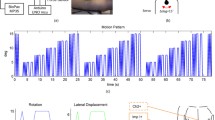Abstract
Artefacts arising from variations in potential across the skin pose the greatest artefact problem remaining in a well designed biopotential recording system. We examined the nature of skin potential artefacts caused by stretch deformation, often called ‘motion artefacts’, and the manner by which skin abrasion reduces these artefacts, using a simultaneous skin-potential and impedence-measuring device to verify a simple d.c. electrical model of the skin. We found that abrasion reduces artefacts by resistively loading the high-impedance transcutaneous potential generator within the epidermis. We devised a needle-puncture method for producing the minimum amount of skin abrasion required to eliminate stretch artefact. We found that 10 0·5-mm skin punctures reduced the artefact from 5–10 mV to less than 0·2 mV. Skin irritation and redness are absent in the majority of cases, but cause a slight reddening in some cases. In contrast, sandpaper abrasion by an inexperienced operator often results in large welts and scabbing. We recommend puncture in clinical recording where motion artefact is a problem.
Sommaire
Les artefacts issus des variations de potentiel sur la surface de la peau posent le dernier sérieux problème encore dans un système d’enregistrement du biopotentiel bien conçu. Nous avons examiné la nature des artefacts potentiels de la peau causés par la déformation due à l’extension, souvent appelés ‘artefacts de mouvement’, ainsi que la manière dont l’abrasion cutanée réduit ces artefacts, en utilisant un appareil mesurant à la fois le potentiel de la peau et l’impédance afin de vérifier un modèle électrique simple de la peau. Nous avons trouvé que l’abrasion réduit l’artefact en créant une charge de résistance dans le générateur de potentiel transcutané à haute impédance à l’intérieur de l’épiderme. Nous avons inventé une méthode qui utilise des piqûres d’aiguilles ce qui permet de produire le minimum d’abrasion requis pour éliminer l’artefact d’extension. Nous avons établi que 10 piqûres cutanées réduisent l’artefact de 5–10 mV à moins de 0·2 mV. L’irritation et la rougeur cutanées causées par notre méthode de piqûres disparaît en 24 h, ce qui contraste nettement avec les escarres qui sont la conséquence fréquente de la technique couramment employée d’abrasion au papier de verre. Nous recommandons donc la technique des piqûres dans les enregistrements cliniques où l’artefact de mouvement pose un problème.
Zusammenfassung
Aus Schwankungen im Hautpotential entstehende Artifakte stellen das schwierigste Artifaktproblem dar, das auch heute noch in einem gut konstruierten Biopotential-Aufzeichnungs-system zu finden ist. Wir untersuchten durch Spannungsverformung verursachte Hautpotential-Artifakte und die Verringerung dieser Artifakte durch Hautabrasion, wobei ein Simultan-Hautpotential-und Impedanzmeßgerät zur Kontrolle eines einfachen Gleichstrom-Modells der Haut herangezogen wurde. Wir fanden, daß Hautabrasion das Artifakt reduziert, indem sie den transkutanen Potentialgenerator in der Epidermis ohmisch belastet. Wir arbeiteten eine Nadelpunktionsmethode aus, die die zur Ausschaltung von Spannungsartifakten erfoderliche Mindestabrasion herstellt. Wir fanden, daß 10 Punktionen das Artifakt von 5–10 mV auf weniger als 0·2 mV reduzierten. Durch unsere Punktion verursachte Hautreizungen und rötungen verschwanden innerhalb von 24 Stunden, im Gegensatz zu der Schorfbildung, die sich aus den herkömmlichen Abrasionsverfahren mit Sandpapier ergibt. Daher empfehlen wir Punktion in klinischen Aufzeichnungen, wo Bewegungsartifakt ein Problem ist.
Similar content being viewed by others
References
Almasi, J. andSchmitt, O. H. (1974) Automated measurement of bioelectric impedance at very low frequencies.Comput. and Biomed. Res.,7, 449–456.
Bockris, J. andReddy, A. (1970)Modern Electrochemistry. Plenum, New York, 287–317.
Burbank, D. P. (1976) Reducing skin potential motion artifact by skin abrasion. Master’s thesis, University of Wisconsin. Madison, WI.
Christie, M. J. andVenables, P. H. (1971) Sodium and potassium electrolytes and ‘basal’ skin potential levels in male and female subjects.Japanese J. Physiol.,21, 659–668.
Edelberg, R. (1963) Electrophysiologic characteristics and interpretation of skin potentials. USAF School of Aerospace Medicine, Tech. Doc. Rep. 63-95.
Edelberg, R. (1968) Biopotentials from the skin surface: the hydration effect.Ann. N. Y. Acad. Sci.,148, 252–262.
Edelberg, R. (1973) Local electrical responses of the skin to deformation.J. of Appl. Physiol.,34, 3, 334–340.
Fowles, D. (1974) Mechanisms of electrodermal activity. InBioelectric recording techniques, Pt. C. Eds.R. F. Thompson andM. M. Patterson. Academic Press, New York.
Hanish, H. M., Neustein, R. A., Vancott, C. C., Sanders, R. T. (1971) Technical aspects of monitoring heart rate of active persons.Amer. J. Clin. Nut.,24, 9, 1155–1163.
Huhta, J. C. andWebster, J. G. (1973) 60-Hz interference in electrocardiography.IEEE Trans., BME-20, 91–101.
Kahn, A. andGreatbatch, W. (1974) Physiologic electrodes. InMedical engineering Ed.C. D. Ray. Yearbook Medical Publishers, Chicago.
Kligman, A. (1964) The biology of the stratum corneum. InThe Epidermis. Eds.W. Montagna andW. C. Lobitz. Academic Press, New York.
Plonsey, R. (1969)Bioelectric phenomend. McGraw-Hill, New York.
Rein, H. (1928) Die Elektrophysiologie der Haut. InHandbuch der Haut und Geschlechtkrankheiten. Ed.J. Jadassohn, J. Springer, Berlin.
Rothman, S. (1954)Physiology and biochemistry of the skin. University of Chicago Press, Chicago.
Shackel, B. (1959) Skin drilling: A method of diminishing galvanic skin potentials.Amer. J. Psych.,72, 114–121.
Stevens, W. G. S. (1963) The current-voltage relationship in human skin.Med. Electron. and Biol. Eng.,1, 389–399.
Tam, H. andWebster, J. G. (1977) Minimizing electrode motion artifact by skin abrasion.IEEE Trans., ME-24, 134–139.
Author information
Authors and Affiliations
Rights and permissions
About this article
Cite this article
Burbank, D.P., Webster, J.G. Reducing skin potential motion artefact by skin abrasion. Med. Biol. Eng. Comput. 16, 31–38 (1978). https://doi.org/10.1007/BF02442929
Received:
Accepted:
Issue Date:
DOI: https://doi.org/10.1007/BF02442929




